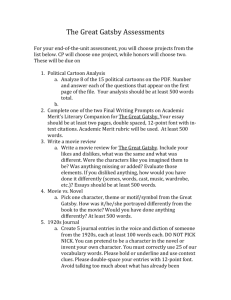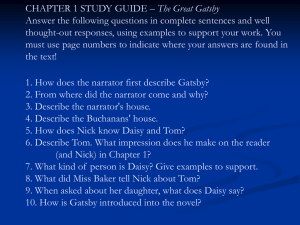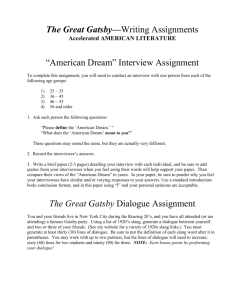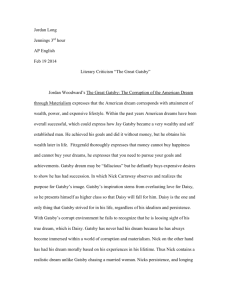The Decline of the American Dream in the 1920s
advertisement
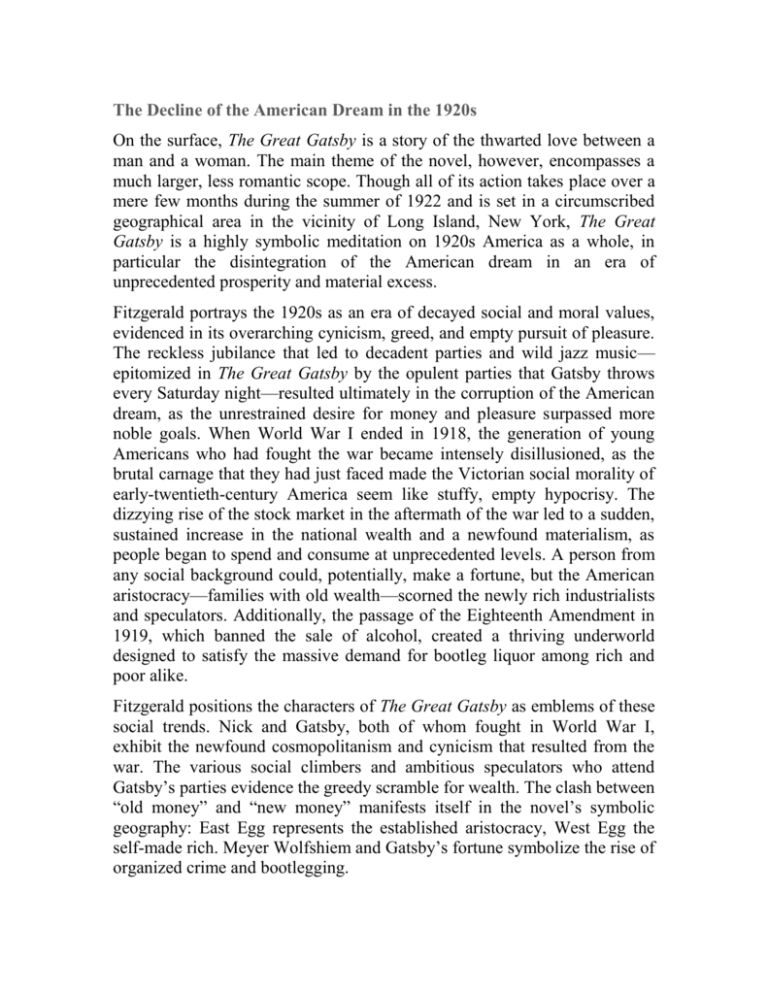
The Decline of the American Dream in the 1920s On the surface, The Great Gatsby is a story of the thwarted love between a man and a woman. The main theme of the novel, however, encompasses a much larger, less romantic scope. Though all of its action takes place over a mere few months during the summer of 1922 and is set in a circumscribed geographical area in the vicinity of Long Island, New York, The Great Gatsby is a highly symbolic meditation on 1920s America as a whole, in particular the disintegration of the American dream in an era of unprecedented prosperity and material excess. Fitzgerald portrays the 1920s as an era of decayed social and moral values, evidenced in its overarching cynicism, greed, and empty pursuit of pleasure. The reckless jubilance that led to decadent parties and wild jazz music— epitomized in The Great Gatsby by the opulent parties that Gatsby throws every Saturday night—resulted ultimately in the corruption of the American dream, as the unrestrained desire for money and pleasure surpassed more noble goals. When World War I ended in 1918, the generation of young Americans who had fought the war became intensely disillusioned, as the brutal carnage that they had just faced made the Victorian social morality of early-twentieth-century America seem like stuffy, empty hypocrisy. The dizzying rise of the stock market in the aftermath of the war led to a sudden, sustained increase in the national wealth and a newfound materialism, as people began to spend and consume at unprecedented levels. A person from any social background could, potentially, make a fortune, but the American aristocracy—families with old wealth—scorned the newly rich industrialists and speculators. Additionally, the passage of the Eighteenth Amendment in 1919, which banned the sale of alcohol, created a thriving underworld designed to satisfy the massive demand for bootleg liquor among rich and poor alike. Fitzgerald positions the characters of The Great Gatsby as emblems of these social trends. Nick and Gatsby, both of whom fought in World War I, exhibit the newfound cosmopolitanism and cynicism that resulted from the war. The various social climbers and ambitious speculators who attend Gatsby’s parties evidence the greedy scramble for wealth. The clash between “old money” and “new money” manifests itself in the novel’s symbolic geography: East Egg represents the established aristocracy, West Egg the self-made rich. Meyer Wolfshiem and Gatsby’s fortune symbolize the rise of organized crime and bootlegging. As Fitzgerald saw it (and as Nick explains in Chapter 9), the American dream was originally about discovery, individualism, and the pursuit of happiness. In the 1920s depicted in the novel, however, easy money and relaxed social values have corrupted this dream, especially on the East Coast. The main plotline of the novel reflects this assessment, as Gatsby’s dream of loving Daisy is ruined by the difference in their respective social statuses, his resorting to crime to make enough money to impress her, and the rampant materialism that characterizes her lifestyle. Additionally, places and objects in The Great Gatsby have meaning only because characters instill them with meaning: the eyes of Doctor T. J. Eckleburg best exemplify this idea. In Nick’s mind, the ability to create meaningful symbols constitutes a central component of the American dream, as early Americans invested their new nation with their own ideals and values. Nick compares the green bulk of America rising from the ocean to the green light at the end of Daisy’s dock. Just as Americans have given America meaning through their dreams for their own lives, Gatsby instills Daisy with a kind of idealized perfection that she neither deserves nor possesses. Gatsby’s dream is ruined by the unworthiness of its object, just as the American dream in the 1920s is ruined by the unworthiness of its object— money and pleasure. Like 1920s Americans in general, fruitlessly seeking a bygone era in which their dreams had value, Gatsby longs to re-create a vanished past—his time in Louisville with Daisy—but is incapable of doing so. When his dream crumbles, all that is left for Gatsby to do is die; all Nick can do is move back to Minnesota, where American values have not decayed.
